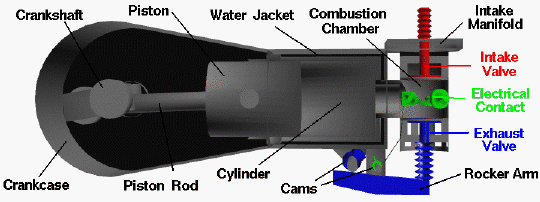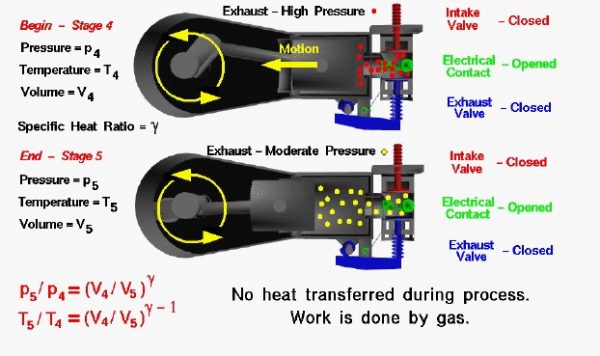Power Stroke
This is a computer drawing of one cylinder of the Wright brothers’ 1903 aircraft engine. This engine powered the first, heavier than air, self-propelled, maneuverable, piloted aircraft; the Wright 1903 Flyer. The engine consisted of four cylinders like the one shown above, with each piston connected to a common crankshaft which turns the propellers to produce thrust.
The brothers’ design is very simple by today’s standards, so it is a good engine for students to study to learn the fundamentals of engine operation. This type of internal combustion engine is called a four-stroke engine because there are four movements (strokes) of the piston before the entire engine firing sequence is repeated. In the figure, we have colored the fuel/air intake system red, the electrical system green, and the exhaust system blue. We also represent the fuel/air mixture and the exhaust gases by small colored balls to show how these gases move through the engine. Since we will be referring to the movement of various engine parts, here is a figure showing the names of the parts:

Mechanical Operation
At the end of the combustion process the combustion chamber is filled with exhaust gases at high pressure and temperature. From our considerations of the engine cycle, we designate this condition as Stage 4 of the Otto cycle. The intake and exhaust valves are closed and the electrical contact switch is open. With both valves closed, the combination of the cylinder and combustion chamber form a completely closed vessel containing exhaust gases. The piston is pushed to the left because of the high pressure on the face of the piston. As the piston moves to the left, the volume is increased as the exhaust gas expands. When the piston has moved completely to the left, we designate the conditions as Stage 5 of the cycle. At the beginning of Stage 5, residual heat in the exhaust mixture is transferred to the water jacket.
Thermodynamics
During the power stroke, no heat is transferred to the exhaust gases. As the volume is increased because of the piston’s motion, the pressure in the gas is decreased. In the figure, the mixture has been colored red at stage 4 and yellow at stage 5 to denote a moderate decrease in pressure. Unlike the compression stroke, the hot gas does work on the piston during the power stroke. The force on the piston is transmitted by the piston rod to the crankshaft, where the linear motion of the piston is converted to angular motion of the crankshaft. The work done on the piston is then used to turn the shaft, and the propellers, and to compress the gases in the neighboring cylinder’s compression stroke. There are thermodynamic equations which relate the pressure decrease and temperature decrease to the change in volume:
p5 / p4 = (V4 / V5) ^ gamma
T5 / T4 = (V4 / V5) ^ (gamma – 1)
where p is the pressure, T is the temperature, V is the volume of the mixture, and gamma is the ratio of specific heats of the mixture. The numbers indicate the two stages of the cycle. Since V4 is less than V5 and gamma is greater than 1 (1.4 for pure air), then p5 is less than p4 and T5 is less than T4. Pressure and temperature of the exhaust both decrease during the power stroke, and the final value (p5 and T5) depends only on a geometric expansion ratio (V4/V5) to some power multiplied by the initial value (p4 and T4).

